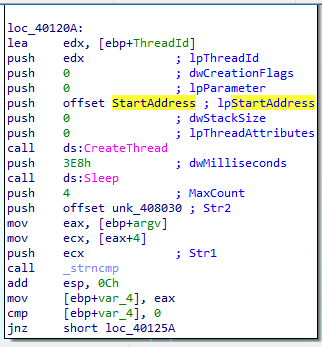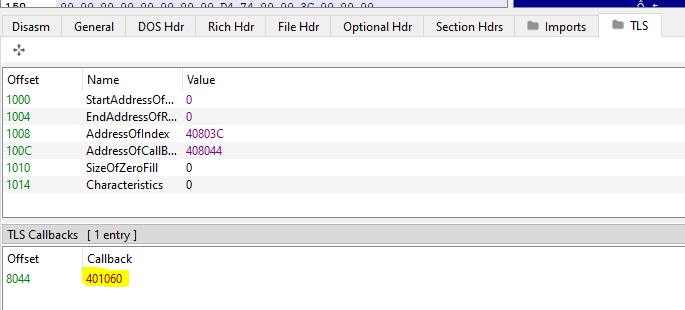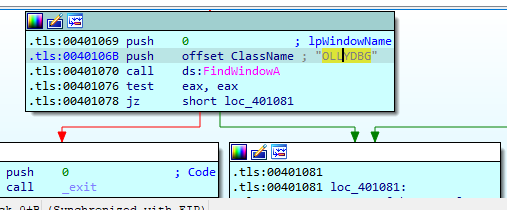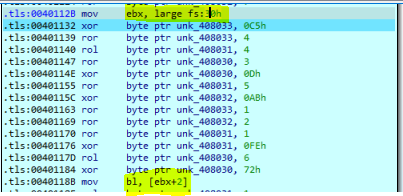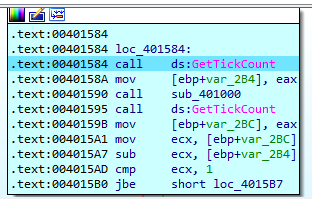Chapter-16 PMA Write-up
Chapter 16 challenges the walkthrough
This chapter discussed Anti-debugging techniques.
Lab16-1.exe
Analyze the malware found in Lab16-01.exe using a debugger.
Q1- Which anti-debugging techniques does this malware employ?
If we open this malware in x64dbg and go to main function we will see that this malware will get the PEB structure and then get (BeingDebugged , ProcessHeap , NtGlobalFlag) flags to check the existence of the debugger.
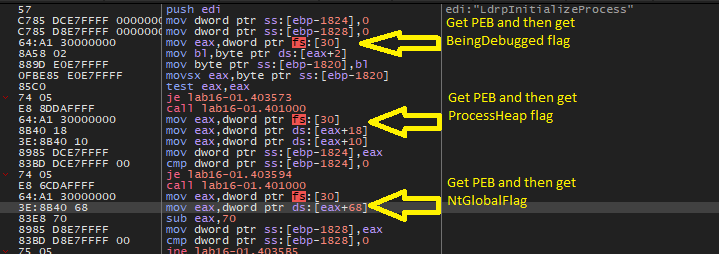
Q2- What happens when each anti-debugging technique succeeds?
As we can see in the image above, if any anti-debugging checking succeeds there is a call to sub401000. If we examine this function
As we can see this function will get our binary path and then pass it and /c del argument to ShellExecute function. So, if the malware notice that there is a debugger, it will delete itself.
Q3- How can you get around these anti-debugging techniques?
We can modify conditional jump instructions to the opposite one, so, we can convert jz to jnz and vice versa. Or we can change the ZF after each comparison.
Q4- How do you manually change the structures checked during runtime?
We can modify PEB flags by right click on their location for example the malware uses eax to hold PEB address and then accesses offset 0x2 to get BeingDebugged flag, so, we can click on [eax+2] and follow it on the memory dump and edit the value to whatever we want. Or we can simply type this command dump fs:[30] + 2 on the command window in the debugger and the debugger will take us to this offset.
Q5- Which OllyDbg plug-in will protect you from the anti-debugging techniques used by this malware?
For me, I use x64dbg and I use ScyllaHide plug-in to avoid debugging detection.
Lab16-2.exe
Analyze the malware found in Lab16-02.exe using a debugger. The goal of this lab is to figure out the correct password. The malware does not drop a malicious payload.
Q1- What happens when you run Lab16-02.exe from the command line?
The malware will ask me to put in a 4-character password.
Q2- What happens when you run Lab16-02.exe and guess the command-line parameter?
If we try a random password like abcd, the malware will print Incorrect password, Try again.
Q3- What is the command-line password?
If we open this malware in IDA, we will find that it will create a thread called StartAddress which will write content in str2, and then it will take our parameter and compare two values.
If we try to debug this code in IDA and see what will be put in str2, we will see that it will contain a value of bzqr
If we try to enter it as a password, it will print an incorrect password also. So, we need to go deep inside this malware to figure out what is the correct password.
Q4- Load Lab16-02.exe into IDA Pro. Where in the main function is strncmp found?
strncmp located at 0040123A
Q5- What happens when you load this malware into OllyDbg using the default settings?
I use x64dbg, but I figure out what is going on.
When we usually run a binary in the debugger, the debugger first goes to Entry point of this binary.
But, in this malware, the x64dbg goes to function before reaching the malware’s entry point. This is an indication that this malware may be using TLS callbacks.
To ensure that this malware uses this technique or not, we can check the PE header in any PE parser tool like PEview or PE-bear
As we can see the addresses of the TLS callback in x64dbg and PE-bear are identical.
If we try to open this malware in ollydbg because of this TLS callback the malware will terminate itself.
Q6- What is unique about the PE structure of Lab16-02.exe?
This malware has a TLS section in its PE header.
Q7- Where is the callback located? (Hint: Use CTRL-E in IDA Pro.)
As we find in x64dbg and PE-bear, the TLS located at 401060
Q8- Which anti-debugging technique is the program using to terminate immediately in the debugger and how can you avoid this check?
If we look at TLS callback in IDA, we will see that this malware will check for any window named OLLYDBG using FindWindowA API.
If the malware doesn’t find any window with this name it will check on arg_4 if it equals 2 it will try another anti-debugging technique which is OutputDebugStringA.
if the malware passes all checks it will go to the main and execute its mal code.
We can avoid these techniques by first making our debugger breaks on TLS callbacks and then we can edit conditional jumping on it, and we can use ScyllaHide plug-in to avoid the techniques implemented in this callback.
Q9- What is the command-line password you see in the debugger after you disable the anti-debugging technique?
If we return to the main in IDA, as we say above there is a thread called StartAddress will put a value in str2 which is bzqr, if we enter this value as a parameter to this file and debug it, it will accept it. But, if we type this password in a command line it will print that this password is incorrect. So, we can predict that StartAddress has an anti-debugging technique to confuse us.

So, let’s see what is inside it.
Inside StartAddress there is an encoding routine, but also there is access to PEB structure especially offset 2.
And if the value of this flag = 1 it will produce the password bzqr, but if we edit the flag value to be 1, the malware will produce a password which is bzrr
And if we try to type this password in the command line, the malware will print that the password is correct.
Q10- Does the password found in the debugger work on the command line?
The password we found in the debugger bzqr doesn’t work on the command line.
Q11- Which anti-debugging techniques account for the different passwords in the debugger and on the command line, and how can you protect against them?
Inside the function that will produce the password to compare it will apply BeingDebuuged checking to see if there is a debugger or not.
We can protect against this technique by using a ScyllaHide plug-in or manually modifying the flag value.
Lab16-3.exe
Analyze the malware in Lab16-03.exe using a debugger. This malware is similar to Lab09-02.exe, with certain modifications, including the introduction of anti-debugging techniques. If you get stuck, see Lab 9-2.
Q1- Which strings do you see when using static analysis on the binary?
If we get the hardcoded string inside this malware we will find some APIs can be used for anti-debugging techniques like GetTickCount and another for network connections like WSASocketA and the last ones seems that this malware will delete itself if it notices the debugger.
Sleep
GetTickCount
GetModuleFileNameA
QueryPerformanceCounter
ShellExecuteA
WSASocketA
ExitProcess
TerminateProcess
cmd.exe
>> NUL
/c del
Q2- What happens when you run this binary?
Nothing, the malware will terminate immediately.
Q3- How must you rename the sample in order for it to run properly?
If we load this malware into IDA, we will find that the malware will construct a string and then compare this string with the file name and if they was not identical the malware will exit.
Then the malware will compare its name with str1 which is ocl.exe.
If we rename our sample to ocl.exe it also will do nothing.
If we scroll down in the code we will find that the malware will push str1 as a parameter to sub_4011E0 if we step over this function and see what is inside str1 we will find that a different value loaded into it qgr.exe. So, let’s go deep inside this function and see what happened.
The first thing we will notice inside this function is that it will call QueryPerformanceCounter and then in this function, the malware will generate an exception.

Then it will call QueryPerformanceCounter again and subtract the second return value from the first return value and compare the difference with 4B0h
If the difference is greater than the value it will move 2 to [ebp+var_118] which is initialized to be 1 at the start of the function.
After that, we will see that this is an encoding routine to convert ocl.exe to qgl.exe
If we NOPing this instruction which moves 2 to [ebp+var_118] and debugs the code, the encoding will produce another name peo.exe

So, now we have three names we can rename our malware to it.
If we try the three names the last one peo.exe will run properly.
So, we can change the jle instruction in sub_4011E0 to jg or NOPing the move instruction to get the correct file name.
Q4- Which anti-debugging techniques does this malware employ?
For this point, this malware uses QueryPerformanceCounter as an anti-debugging techniue. But if we go deep in the main function we will find more techniques used.
After the file name comparison succeeds, the malware will set up a network connection using WSAStartup and WSASocketA, then at location loc_401584 there is a suspicious logic performed.
The malware will call GetTickCount and then call sub_401000 and then GetTickCount again.
If we go to inside sub_401000 we will see almost the same logic in sub_4011E0 it will generate a divide by zero exception.
After this function returns, the abstraction between the return value from the first GetTickCount and the second one will be performed and compare the difference with 1 and if the difference is below or equal it will continue, but if not they are some logic on 004015B2 to xor eax and load the value on edx on the effective address of eax and then return from main.
This logic will cause an access violation exception which will crash the process.
So, we can avoid this technique by modifying jbe with the opposite one.
After bypassing this check, the malware will call sub_401300 which will also generate a divide by zero exception and if we pass this exception to the program to handle it, it won’t handle it and the malware will be deleted.
So, let’s go inside this function and see what happened.
As we know this function will generate a divide by zero exception but after and before exception generation, the malware will call rdtsc instruction twice at locations (00401323 , 0040136D) then it will get the difference and compare it with 7A120h and if the difference is above it will call sub_4010E0
If we take a look in sub_4010E0, we will see the delete logic to delete the file.
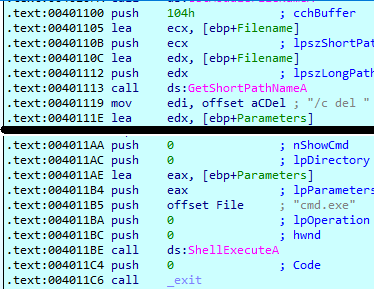
So, if this technique notices the debugger existence it will delete the file.
Q5- For each technique, what does the malware do if it determines it is running in a debugger?
-
The first technique will confuse you by comparing the file name with
qgr.exe, so, if you would rename the malware with this name it won’t run without the debugger. -
The second technique will cause an access violation exception and crash the process.
-
The third technique will delete the malware from the desk.
Q6- Why are the anti-debugging techniques successful in this malware?
I think because these techniques plays on time and all of them generate an exception, so, if the malware running under the debugger it will be detected.
Q7- What domain name does this malware use?
By turning on WireShark on Remnux with inetsim we can see that after all debugger checks passed the malware will try to connect to adg.malwareanalysisbook.com



